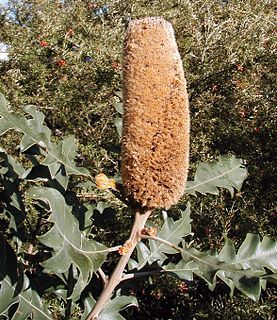
Banksia solandri, commonly known as Stirling Range banksia, is a species of large shrub in the plant genus Banksia. It occurs only within the Stirling Range in southwest Western Australia. Its scientific name honours the botanist Daniel Solander, one of the first collectors of Banksia.
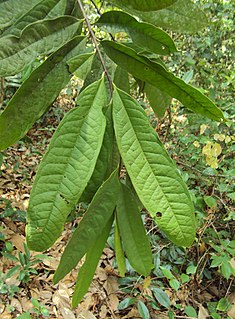
Goniothalamus is one of the largest palaeotropical genera of plant in family Annonaceae.
Goniothalamus cheliensis is a species of plant in the Annonaceae family. It is native to China and Thailand. Bioactive molecules isolated from its roots have been reported to have cytotoxic activity in tests with cultured human cancer cells.

Goniothalamus chinensis is a species of plant in the Annonaceae family. It is found in China and Vietnam.
Goniothalamus gardneri is a species of plant in the Annonaceae family. It is endemic to Sri Lanka.
Goniothalamus macrocalyx is a species of plant in the Annonaceae family. It is endemic to Vietnam.
Goniothalamus majestatis is a species of plant in the Annonaceae family. It is endemic to Sulawesi in Indonesia.
Goniothalamus rhynchantherus is a species of plant in the Annonaceae family. It is native to Kerala and Tamil Nadu in India. It is threatened by habitat loss.
Goniothalamus simonsii is a species of plant in the Annonaceae family. It is endemic to Meghalaya in India.

Goniothalamus wynaadensis is a species of plant in the Annonaceae family. It is endemic to India.
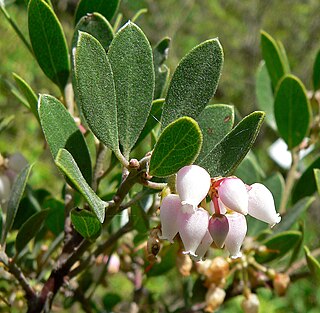
Arctostaphylos hookeri is a species of manzanita known by the common name Hooker's manzanita.
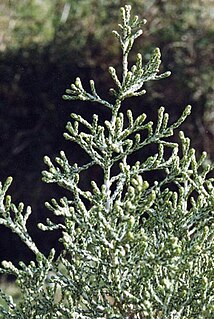
Ozothamnus hookeri, commonly known as kerosene bush, is an aromatic shrub species, endemic to Australia. It grows to between 0.5 and 1 metre in height and has white-tomentose branchlets. The scale-like leaves are 4 to 5 mm long and 0.5 to 1 mm wide. These are green on the upper surface, and white tomentose below. The flower heads appear in dense clusters in summer and autumn The species occurs in boggy sites and subalpine heathland New South Wales and Tasmania.

Drosera hookeri, the grassland sundew is an shortly erect perennial tuberous species in the carnivorous plant genus Drosera. Drosera hookeri is found in south-eastern Australia. Although the holotype was collected in Tasmania, its distribution also includes Victoria, New South Wales and South Australia. This species has a complex taxonomic history, and its specific epithet acknowledges the original recognition of the taxon by Joseph Dalton Hooker. Hooker originally called his species Drosera foliosa Hook.f. ex Planch. in 1848, a name that was illegitimate as it had previously been used to describe a different species. The nomenclature of D. hookeri was later clarified and the taxonomic concept significantly broadened to include most of the south-eastern Australian and New Zealand forms of the species complex that includes Drosera peltata.

Goniothalamus giganteus is a species of plant in the family Annonaceae. It is native to Malaya, Myanmar, Sumatra and Thailand. Joseph Dalton Hooker and Thomas Thomson, the British botanists who first formally described the species, named it after its exceptionally large flowers.

Goniothalamus griffithii is a species of plant in the family Annonaceae. It is native to Myanmar and Thailand. Joseph Dalton Hooker and Thomas Thomson the British botanists who first formally described the species, named it in honor of William Griffith, another British botanist who collected the specimen they examined.
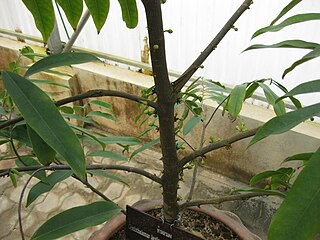
Goniothalamus laoticus is a species of plant in the family Annonaceae. It is native to Laos and Thailand. It was originally described by the French botanists Achille Eugène Finet and François Gagnepain using the basionym Mitrephora laotica. In Thailand it is commonly called Khao Lam-dong and is used as a traditional medicine.
Goniothalamus rotundisepalus is a species of plant in the family Annonaceae. It is native to Peninsular Malaysia and Thailand. Murray Ross Henderson, the Scottish botanist who first formally described the species, named it after its sepals which are rounded like the arc of a circle.
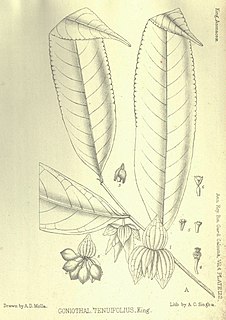
Goniothalamus tenuifolius is a species of plant in the family Annonaceae. It is native to Peninsular Malaysia, Thailand and Vietnam. George King, the British botanist who first formally described the species, named it after its slender leaved foliage.
Conospermum hookeri, commonly known as the Tasmanian smokebush, is a plant endemic to Tasmania.
Stylidens is an extinct genus of mammaliaforms, possibly belonging to Morganucodonta, that lived in what is now England during the Middle Jurassic. Its type species is Stylidens hookeri, which was named in 2016 by Percy M. Butler and Denise Sigogneau-Russell from an isolated lower molar found at the Forest Marble Formation. A second molar referable to the genus is also known, which may represent a separate species.











